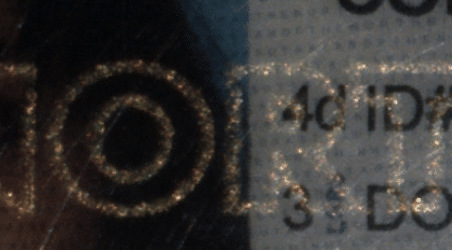ID security features are design elements that can help determine whether an ID is real or fake, and are crucial in preventing ID fraud. Holograms are ne of the more popular ID security features. Because holograms require special printers, paper, and ink, they ensure that regular individuals and fraudsters cannot just print their own fake IDs. Holograms can also be very beautiful; states like to design intricate holograms to beautify their unique drivers license and ID formats.
Although only some states have elements that meet the technical definition of a “hologram”, many states have a pearlescent design overlays which looks very similar and can often be mistaken for a hologram.
While states follow guidelines from either the ICAO or AAMVA for where specific security features should be placed on the respective state ID, the designs differ from state to state, and understanding which states have holograms and pearlescent design elements can help business owners due to their unique three-dimensional effects. These effects can easily be seen without using any special technology. This is because the light is reflected or diffused off the nano-structures, creating an easy to see design.
We extensively examined each state’s ID to help create a better understanding of what to look for when checking IDs for holograms or pearlescent overlay, as you determine an ID’s legitimacy. Given that each state has creative autonomy, the design and number of occurrences of holograms for each state differs. It is also important to note that not all states have holograms or pearlescent overlay incorporated into their ID design. Below we have listed the states we have been able to test with holograms and pearlescent overlay built into the ID security features.






States with known holograms on their IDs
- Alaska
- Arkansas
- Delaware
- Florida
- Georgia
- Hawaii
- Idaho
- Maryland
- Mississippi
- New Hampshire
- New Jersey
- New York
- Rhode Island
- South Carolina
- Texas
- Wyoming






States with pearlescent design elements on their IDs
- Alabama
- Arizona
- California
- Connecticut
- Georgia
- Illinois
- Louisiana
- Michigan
- Minnesota
- Nevada
- New Mexico
- Ohio
- Pennsylvania
- Washington
- Wisconsin
*Subject to change based on release of additional ID formats.
What is the difference between holograms and pearlescent design elements?
Holograms are more reflective in their design. When the light hits these designs at certain angles, the light is diffused to create the rainbow effect that we associate with holograms. Depending on the angle the light hits the design, the color will change accordingly.
Pearlescent overlay is a slightly sparkly effect laid over other design elements of an ID. The plastic of the ID is embedded with metallic particles such that when the light hits it, it is diffused in a way that creates a sparkly or shiny effect. These colors are commonly gold or silver, but can also be other metallic colors.
How do holograms differ from UV marks?
A hologram on an ID is typically a shiny sticker. It provides a degree of depth perception and sparkle. When illuminated, the hologram has a sense of three-dimensionality. Holograms are visible under white light. In some cases, holograms also illuminate under ultraviolet examination, but this is not always the case. For many IDs, only some part of the hologram or pearlescent markings illuminate under UV lights.
UV images or UV marks are a type of watermark that is printed on an ID and visible only under the UV spectrum of light. The UV mark may be an image of anything, but it is not typically intended to be visible in white light or with the naked eye.
Both holograms and UV images are types of security features commonly present on IDs.
How ID authentication helps catch fake IDs
Authentication is the most stringent stage of ID checking. Authentication requires specialty hardware. A phone, or low end scanner, will not be equipped with the type of camera or lighting required to truly put an ID through its paces. ID authentication includes checking the ID against hologram libraries to ensure the hologram matches our records. The following checks occur during ID authentication:
- Minimum 400 DPI image capture for both sides of the ID
- UV hologram screening library
- IR watermark screening library
- White light scanning
- Additional algorithmic checks on the physical ID
ID authentication can be performed concurrently with ID validation. Authentication provides the highest degree of fake detection and accurately catches the majority of suspicious IDs. Even the best fake ID manufacturers have difficulty passing the hundreds of checks that are done in the authentication stage.
ID scanners capable of detecting holograms
The scanners below are capable of examining IDs under multiple light wavelengths to confirm presence of holograms and ultraviolet markings.
How looking at holograms can help you catch fake IDs
Drivers license scanning is a straightforward and simple to increase your security, age verification, and fake detection. Looking for security features such as holograms can help determine which IDs are legitimate and which are fake. However, many new fake IDs do have some hologram elements, and pixel-level template checks are often needed to determine whether the hologram or pearlescent design elements truly conform to jurisdictional standards.
Which state IDs have holograms?
States with known holograms on their IDs
Wyoming, Alaska, Arkansas, Delaware, Florida, Georgia, Hawaii, Idaho, Maryland, Mississippi, New Hampshire, New Jersey, New York, Rhode Island, South Carolina, Texas








